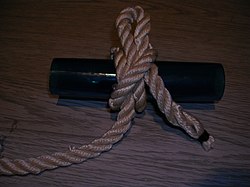Difference between revisions of "Translations:AY Honors/Knot/Slipped half hitch/2/es"
From Pathfinder Wiki
(Created page with "</noinclude> {{Knot/es | name= Nudo cote escurridizo | image= SlipperyHitch.jpg | use = Un «nudo cote escurridizo» es un nudo que se usa para unir una línea a una barra o t...") |
m (FuzzyBot moved page Translations:Adventist Youth Honors Answer Book/Knot/Slipped half hitch/2/es to Translations:AY Honors/Knot/Slipped half hitch/2/es without leaving a redirect: Part of translatable page "Adventist Youth Honors Answer Book/Knot/Slipped half hitch") |
(No difference)
| |
Latest revision as of 15:44, 8 September 2021
| Nudo cote escurridizo |
|---|
|
Uso: Un «nudo cote escurridizo» es un nudo que se usa para unir una línea a una barra o tubo. No proporciona una gran resistencia en comparación con otros nudos, pero se puede atar relativamente rápido y soltar fácilmente. Estas características significan que se usa en naves para asegurar las juntas que atan las velas guardadas.
Cómo amarrar:
ADVERTENCIA: Nunca use este nudo en una situación crítica. Se desata a la menor provocación.
|

